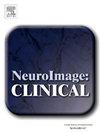Reshaped functional connectivity gradients in acute ischemic stroke
IF 3.6
2区 医学
Q2 NEUROIMAGING
引用次数: 0
Abstract
Ischemic brain stroke disrupts blood flow, leading to functional and structural changes associated with behavioral deficits. Importantly, despite this disruption occurring in localized regions, the resulting changes in the functional organization are both high-dimensional and widespread across the human cortex. However, the mechanisms with which these global patterns emerge and the subsequent behavioral deficits they entail, remain largely unexplored. Functional connectivity gradients provide consistent, reproducible, and robust low-dimensional representations of brain function that can be explored to reduce brain heterogeneity to a handful of axes along which brain function is organized. Here, we investigated how stroke disrupts this canonical gradient space by aligning each patient to a control-averaged gradient embedding and computing the distances to the “correct” positions to quantify functional deviations and their contribution to behavioral deficits. Importantly, we explicitly corrected these gradients for stroke-induced hemodynamic lags to further study their contribution. We found that lag correction enhanced the functional connectivity gradients most prominently in the second gradient, on which visual and somatomotor function is concentrated. Additionally, we identified significant functional deviations primarily within somatomotor, visual, and ventral attention networks, correlating with behavioral impairments. We studied the hemispheric asymmetries of these deviations finding that intact hemispheres preserve comparable patterns of asymmetry while damaged ones presented important changes. Lastly, right-sided lesions displayed more localized functional deviations than their contralateral lesions. Overall, we provide evidence that (1) correcting for hemodynamic lags improves gradient accuracy, as indicated by increased percentages of explained variance, and (2) behavioral impairments and hemispheric asymmetries result from a repositioning of region-based connectivity profiles in a low-dimensional interpretable space. This suggests that large-scale brain function alterations manifest in slight, predictable movements along a reduced set of brain axes that are not completely detached from white matter damage.
重塑的功能连接梯度在急性缺血性脑卒中
缺血性脑卒中会扰乱血液流动,导致与行为缺陷相关的功能和结构变化。重要的是,尽管这种破坏发生在局部区域,但在功能组织中产生的变化是高维的,并且在人类皮层中广泛存在。然而,这些全球模式产生的机制以及随之而来的行为缺陷在很大程度上仍未被探索。功能连接梯度提供了一致的、可重复的、稳健的脑功能低维表征,可以探索将大脑异质性减少到少数几个脑功能组织的轴。在这里,我们通过将每个患者对齐到控制平均梯度嵌入并计算到“正确”位置的距离来量化功能偏差及其对行为缺陷的贡献,研究了中风如何破坏这个规范梯度空间。重要的是,我们明确修正了这些梯度,以进一步研究它们的作用。我们发现,滞后校正对功能连接梯度的增强在第二梯度中最为显著,其中视觉和躯体运动功能集中。此外,我们主要在躯体运动、视觉和腹侧注意网络中发现了与行为障碍相关的显著功能偏差。我们研究了这些偏差的半球不对称性,发现完整的半球保留了类似的不对称性模式,而受损的半球则呈现出重要的变化。最后,右侧病变比对侧病变表现出更多的局部功能偏差。总的来说,我们提供的证据表明:(1)校正血流动力学滞后可以提高梯度精度,这可以通过增加可解释方差的百分比来表明;(2)在低维可解释空间中重新定位基于区域的连接特征会导致行为障碍和半球不对称。这表明,大规模的大脑功能改变表现为沿着一组减少的大脑轴的轻微、可预测的运动,这些运动并没有完全脱离白质损伤。
本文章由计算机程序翻译,如有差异,请以英文原文为准。
求助全文
约1分钟内获得全文
求助全文
来源期刊

Neuroimage-Clinical
NEUROIMAGING-
CiteScore
7.50
自引率
4.80%
发文量
368
审稿时长
52 days
期刊介绍:
NeuroImage: Clinical, a journal of diseases, disorders and syndromes involving the Nervous System, provides a vehicle for communicating important advances in the study of abnormal structure-function relationships of the human nervous system based on imaging.
The focus of NeuroImage: Clinical is on defining changes to the brain associated with primary neurologic and psychiatric diseases and disorders of the nervous system as well as behavioral syndromes and developmental conditions. The main criterion for judging papers is the extent of scientific advancement in the understanding of the pathophysiologic mechanisms of diseases and disorders, in identification of functional models that link clinical signs and symptoms with brain function and in the creation of image based tools applicable to a broad range of clinical needs including diagnosis, monitoring and tracking of illness, predicting therapeutic response and development of new treatments. Papers dealing with structure and function in animal models will also be considered if they reveal mechanisms that can be readily translated to human conditions.
 求助内容:
求助内容: 应助结果提醒方式:
应助结果提醒方式:


